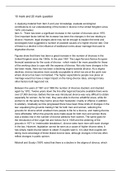Exam (elaborations)
Applying material from Item A and your knowledge, evaluate sociological contributions to our understanding of the trends in divorce in the United Kingdom since 1970. (20 marks)
- Course
- Institution
- Book
What are the reasons as to why divorce rates had a sudden rise in the 1960s. Talks about the many different ways in which this could be explained for instance declining stigma, secularisation and so on.
[Show more]













